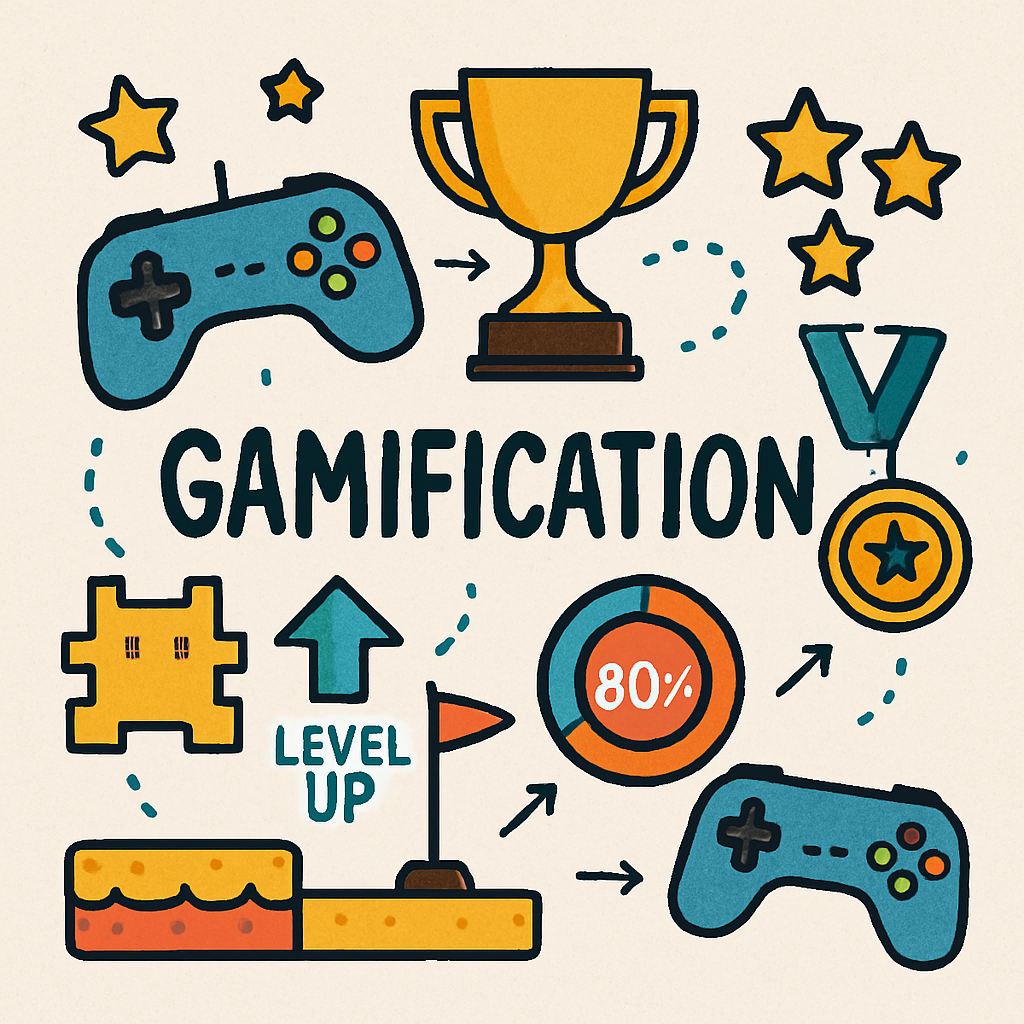Playzo - Level up your marketing with gamified content
Boost sales and capture more leads using highly engaging games and AI-generated quizzes
Playzo was born from a clear gap in the market for truly flexible gamified content. Founders experienced frustration with rigid quiz and game platforms that lacked advanced features like timers, video embeds, and custom mechanics.
They envisioned a tool that empowers marketers, educators, and content creators to craft engaging, interactive experiences without technical barriers. By integrating AI-powered quiz generation, extensive game templates, and full customization, Playzo turns static marketing and e-learning into dynamic, rewarding journeys.
Built on community feedback, Playzo continually expands its library and refines its editor to ensure users can design, play, and share captivating games that boost leads, reinforce learning, and drive conversions.
Engage your audience with Playzo
Gamification in Marketing: The Ultimate Tool for Boosting Engagement and Loyalty
In today's highly competitive landscape, engaging your audience and maintaining their loyalty can be incredibly challenging. Traditional marketing tactics, while still valuable, may not always suffice in capturing and retaining customer interest. This is where gamification comes into play, transforming the way brands interact with their audiences. Gamification in marketing involves incorporating game elements into your marketing strategy to capture interest, encourage interaction, and foster loyalty among customers. By leveraging the intrinsic appeal of games, businesses can create more dynamic and compelling marketing campaigns that resonate with modern consumers.

The Evolution of Gamification
Gamification has evolved significantly over the years, moving from simple point systems to more sophisticated and immersive experiences. Early implementations focused on basic rewards and point systems, which have now expanded into complex ecosystems of engagement. This evolution reflects changing consumer expectations and technological advancements, making it possible to create more personalized and interactive experiences. As technology continues to advance, the potential for gamification in marketing grows, offering new opportunities for brands to connect with their audiences in meaningful ways.
Core Principles of Gamification
At its core, gamification relies on several key principles: motivation, engagement, and reward. These principles are designed to tap into human psychology, encouraging users to participate actively. Motivation can be driven by competition, achievement, and the desire for social interaction. Engagement is fostered through interactive and challenging content, while rewards provide tangible incentives for participation. Understanding these principles is crucial for designing effective gamification strategies that resonate with target audiences.
Gamification vs. Traditional Marketing
While traditional marketing focuses on delivering messages and information, gamification emphasizes interaction and participation. This shift from passive consumption to active engagement is what sets gamification apart. Traditional marketing often relies on one-way communication, whereas gamification creates a two-way interaction between the brand and the consumer. This interactive approach not only captures attention but also encourages deeper engagement, making it a valuable addition to any marketing strategy.
How Does Gamification Work?
Gamification works by leveraging people's natural desires for competition, achievement, and social interaction. By incorporating elements such as points, badges, leaderboards, and challenges into your marketing campaigns, you can motivate users to engage more deeply with your brand. These elements are designed to create a sense of accomplishment and community, driving sustained engagement and loyalty.
The Psychology Behind Gamification
Understanding the psychology behind gamification is key to its effectiveness. Humans are naturally drawn to challenges, competition, and the satisfaction of achieving goals. Gamification taps into these instincts by providing structured challenges and rewards. The anticipation of a reward or the thrill of competition can significantly increase engagement levels. By designing gamified experiences that align with these psychological drivers, brands can create more compelling and motivating interactions.
Designing Engaging Gamified Experiences
Creating engaging gamified experiences requires careful planning and creativity. It's important to design experiences that are not only fun but also relevant to your brand and audience. This involves selecting the right game elements, such as challenges, rewards, and social features, that align with your marketing objectives. The key is to balance complexity and accessibility, ensuring the experience is challenging yet achievable, keeping users motivated and engaged.
Real-World Applications of Gamification
Gamification can be applied in various ways across different industries. For instance, a loyalty program that rewards customers with points for every purchase they make is a common application. As customers accumulate points, they can unlock new levels, earn badges, and compete with other users on a leaderboard, all of which heighten their engagement and commitment to your brand. Other applications include interactive mobile apps, educational platforms, and social media campaigns that incorporate game mechanics to drive engagement.
The Benefits of Gamification in Marketing
Incorporating gamification into your marketing strategy can yield several benefits, including enhanced
Enhanced Audience Engagement
For example, a mobile app that gamifies the user experience by integrating quizzes and trivia related to your products can keep users engaged longer, increasing the chances of conversion. The interactive nature of gamified content makes it more appealing and memorable, encouraging users to return and participate repeatedly.
Increased Customer Loyalty
A successful example is Starbucks' Rewards program, which uses a points system to encourage repeat purchases. Customers earn stars for every purchase, which can be redeemed for free items, further incentivizing loyalty. This approach not only rewards customers for their loyalty but also creates a sense of exclusivity and belonging.
Valuable Insights and Data
Gamification also provides valuable data and insights into customer behavior. By tracking user interactions and preferences within gamified content, marketers can better understand their audience and tailor future campaigns to meet their needs. This data-driven approach allows for more targeted and effective marketing efforts.
For instance, analyzing which challenges or rewards are most popular can help you refine your strategy and offer more targeted promotions. By leveraging insights gained from gamification, brands can continuously optimize their marketing efforts and deliver more personalized experiences to their audiences.
Implementing Gamification in Your Marketing Strategy
To effectively implement gamification, consider the following steps: defining your objectives, knowing your audience, choosing the right game elements, integrating seamlessly, and monitoring and optimizing your efforts. Each step is crucial for creating a successful gamified marketing strategy that resonates with your audience and achieves your business goals.
Define Your Objectives
Before incorporating gamification, it's essential to clearly define your marketing goals. Are you looking to increase brand awareness, boost sales, or enhance customer loyalty? Having a clear objective will guide your strategy and ensure the gamified elements align with your overall marketing goals. Clearly defined objectives help in measuring success and refining your approach over time.
Know Your Audience
Understanding your target audience is crucial for designing a successful gamification strategy. Consider their interests, preferences, and behaviors to create engaging and relevant game elements that resonate with them. Conducting audience research and segmentation can provide valuable insights into what motivates and engages your audience, helping you tailor your gamification efforts effectively.
Choose the Right Game Elements
Select game elements that complement your brand and appeal to your audience. Points, badges, leaderboards, and challenges are popular options, but it's important to tailor them to fit your brand's identity and marketing objectives. The right combination of game elements can enhance user engagement and drive desired behaviors, making your gamification strategy more effective.
Integrate Seamlessly
Ensure that the gamified content integrates seamlessly with your existing marketing channels. Whether it's a mobile app, website, or social media platform, the gamified experience should be easy to access and navigate. A seamless integration ensures a smooth user experience, reducing friction and encouraging participation. It's important to maintain brand consistency across all channels to reinforce your brand identity.
Monitor and Optimize
Once your gamified marketing campaign is live, continuously monitor its performance and gather feedback from users. Analyze data to identify areas for improvement and make necessary adjustments to optimize the experience. Regular monitoring and optimization ensure that your gamification strategy remains effective and relevant, allowing you to make data-driven decisions and enhance user engagement over time.
Real-World Examples of Gamification in Marketing
Several brands have successfully leveraged gamification to boost engagement and loyalty. Let's explore a few notable examples that demonstrate the effectiveness of gamification in marketing and how it can be applied across different industries.
Nike+ Run Club
Nike's Run Club app is a prime example of gamification in action. The app tracks users' runs and provides personalized coaching, challenges, and rewards to motivate them. Users can earn badges for completing challenges and share their achievements on social media, fostering a sense of community among users. This approach not only enhances user engagement but also builds brand loyalty by creating a supportive and motivational environment.
McDonald's Monopoly

McDonald's annual Monopoly game is a classic example of gamification in marketing. Customers collect game pieces with each purchase, which they can use to win prizes. The game's competitive nature and the potential for rewards drive repeat purchases and increase customer engagement. This long-running campaign demonstrates the power of gamification to create excitement and drive consumer participation.
Duolingo Language Learning
Duolingo, the language-learning app, uses gamification to make learning fun and engaging. Users earn points, unlock new levels, and compete on leaderboards, all while improving their language skills. This gamified approach has contributed to Duolingo's widespread popularity and user retention. By turning language learning into a game, Duolingo has created an engaging and effective educational experience that keeps users motivated and committed.
Conclusion
Gamification in marketing is more than just a buzzword; it's a proven strategy for enhancing










